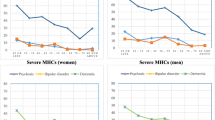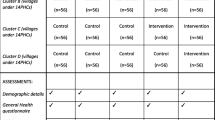Abstract
Purpose
Low community awareness of mental health problems negatively impacts treatment-seeking for such problems. Despite a shortage of mental health providers, there is scope to improve coverage of mental health services in India. In this study, we examined the impact of a multi-state community-based awareness campaign on knowledge, attitude, treatment-seeking behavior and acceptability.
Methods
Campaign activities included educational materials, public meetings, musical announcements, quizzes, and street plays, followed by a mental health screening camp. A rapid, real-world evaluation was conducted using post-intervention surveys (n = 693), field notes and telephonic interviews in five states.
Results
The campaign, implemented as a public–private partnership between government service providers and community-based organizations, reached ~ 3000 people in 20 new locations across five states. As a result of the campaign, 1,176 persons sought treatment services for mental disorders and 66% received a preliminary diagnosis. Collectively, campaign activities were the first time that ~ 75% of participants reported learning about mental health problems. Participants expressed knowledge that mental disorders are treatable, listed common symptoms and location of available mental health services and attitudes supporting people with mental health problems.
Conclusion
The campaign enabled improved coverage for mental health services, potentially by enhancing knowledge, attitude and treatment-seeking behavior. Future research may develop a quasi-experimental evaluation of the current campaign methodology.

Similar content being viewed by others
References
Ajzen, I. (1991). The theory of planned behaviour. Organizational Behavior and Human Decision Processes, 50(2), 179–211.
Bhat, R., Maheshwari, S. K., Rao, K., Bakshi, R. (2007) Mental Health Care Pilots in Gujarat: Processes, Outcomes and Learning. Ahmedabad: Indian Institute of Management. Retrieved from https://www.researchgate.net/profile/Ramesh_Bhat12/publication/282182688_Mental_Health_Care_Pilots_in_Gujarat_Processes_Outcomes_and_Learning/links/5606525f08aea25fce34651d/Mental-Health-Care-Pilots-in-Gujarat-Processes-Outcomes-and-Learning.pdf.
Bhui, K., & Bhugra, D. (2007). Culture and mental health. London: Edward Arnold.
Gaiha, S. M., Sunil, G. A., Kumar, R., & Menon, S. (2014). Enhancing mental health literacy in India to reduce stigma: The fountainhead to improve help-seeking behaviour. Journal of Public Mental Health, 13(3), 146–158.
Government of India. (2011). Census 2011 Data, Office of the Registrar General & Census Commissioner, India, Ministry of Home Affairs. New Delhi: Government of India. Retrieved from website: https://censusindia.gov.in/2011-common/censusdata2011.html.
Government of India. (2014). New Pathways, New Hope: National Mental Health Policy, Ministry of Health and Family Welfare, Government of India. New Delhi: Government of India. Retrieved from PRS Legislative Research website: https://www.prsindia.org/uploads/media/Mental%2520Health/Mental%2520Healthcare%2520Act,%25202017.pdf.
Government of India. (2017). The Mental Healthcare Act, 2017 Section 30 (b), Ministry of Law and Justice, Government of India. Retrieved from PRS Legislative Research website: https://www.prsindia.org/uploads/media/Mental%2520Health/Mental%2520Healthcare%2520Act,%25202017.pdf.
Gururaj, G., Varghese, M., Benegal, V., Rao, G. N., Pathak, K., Singh, L. K., Mehta, R. Y., Ram, D., Shibukumar, T. M., Kokane, A., Lenin Singh, R. K., Chavan, B. S., Sharma, P., Ramasubramanian, C., Dalal, P. K., Saha, P. K., Deuri, S. P., Giri, A. K., Kavishvar, A. B., Sinha, V. K., Thavody, J., Chatterji, R., Akoijam, B. S., Das, S., Kashyap, A., Ragavan, V. S., Singh, S. K., Misra, R. and National Mental Health Survey collaborators group. (2016). National Mental Health Survey of India, 2015–16: Summary(Publication No. 128). Bengaluru, Karnataka: National Institute of Mental Health and Neuro Sciences, NIMHANS (India).
Jagawat, T., Rajdan, R., Joshi, S. B., & Sharma, R. (2010). Changing Scene of Mental Health Care in Shivpuri District of M.P. Delhi Psychiatry Journal, 13(1), 98–100.
Kakuma, R., Minas, H., van Ginneken, N., Dal Poz, M. R., Desiraju, K., Morris, J. E., et al. (2011). Human resources for mental health care: Current situation and strategies for action. The Lancet, 378(9803), 1654–1663.
Kodakandla, K., Nasirabadi, M., & Pasha, M. S. (2016). Attitude of interns towards mental illness and psychiatry: A study from two medical colleges in South India. Asian Journal of Psychiatry., 22, 167–173.
Kohn, R., Saxena, S., Levav, I., & Saraceno, B. (2004). The treatment gap in mental health care. Bulletin of the World Health Organization, 82, 858–866.
Koschorke, M., Evans-Lacko, S., Sartorius, N., & Thornicroft, G. (2017). Stigma in different cultures. The Stigma of Mental Illness-End of the Story? (pp. 67–82). Cham: Springer.
Kumar, P. (2013). Community mental health, Its critique and reappraisal: An Indian Perspective. Delhi Psychiatry Journal, 16(2), 265–272.
Math, S, & Srinivasaraju, R. (2010). Indian psychiatric epidemiological studies: Learning from the past. Indian Journal of Psychiatry, 52(Suppl. 1), S95–S103. https://doi.org/10.4103/0019-5545.69220.
Mental Health Policy Group. (2012). XIIth Plan District Mental Health Programme prepared by Policy Group. New Delhi, Delhi: Policy Group. Retrieved from National Mental Health Programme website: https://mhpolicy.files.wordpress.com/2012/07/final-dmhp-design-xii-plan2.pdf.
National Advisory Mental Health Council. (2000). Translating Behavioral Science Into Action: NIH Publication 00–4699. Bethesda, MD: National Institute of Mental Health.
Nebhinani, N., Nebhinani, M., Misra, A. K., & Grewal, S. (2013). Substance-related knowledge and attitude in school and college students. German Journal of Psychiatry, 16(1), 15–19.
Maulik, P. K., Devarapalli, S., Kallakuri, S., Tewari, A., Chilappagari, S., Koschorke, M., et al. (2017). Evaluation of an anti-stigma campaign related to common mental disorders in rural India: a mixed methods approach. Psychological Medicine, 47(3), 565–575.
Patel, V. (2009). The future of psychiatry in low- and middle-income countries. Psychological Medicine, 39(11), 1759–1762.
Peters, D. H., Adam, T., Alonge, O., Agyepong, I. A., & Tran, N. (2013). Implementation research: what it is and how to do it. BMJ, 347, f6753.
Ram, D., Chandran, S., & Gowdappa, B. (2017). Suicide and depression literacy among healthcare profession students in tertiary care center in South India. Journal of Mood Disorders, 7(3), 149–155.
Rüsch, N., Angermeyer, M. C., & Corrigan, P. W. (2005). Mental illness stigma: Concepts, consequences, and initiatives to reduce stigma. European Psychiatry, 20(8), 529–539.
Saxena, S., Thornicroft, G., Knapp, M., & Whiteford, H. (2007). Resources for mental health: scarcity, inequity, and inefficiency. The Lancet, 370(9590), 878–889.
Shidhaye, R., & Kermode, M. (2013). Stigma and discrimination as a barrier to mental health service utilization in India. International Health, 5(1), 6–8. https://doi.org/10.1093/inthealth/ihs011.
Shidhaye, R., Murhar, V., Gangale, S., Aldridge, L., Shastri, R., Parikh, R., et al. (2017). The effect of VISHRAM, a grass-roots community-based mental health programme, on the treatment gap for depression in rural communities in India: a population-based study. The Lancet Psychiatry, 4(2), 128–135.
Thornicroft, G., Rose, D., Kassam, A., & Sartorius, N. (2007). Stigma: ignorance, prejudice or discrimination? The British Journal of Psychiatry, 190(3), 192–193.
World Health Organization. (2010). International Statistical Classification of Diseases and Related Health Problems 10th Revision (ICD-10 Classification of Mental and Behavioural Disorders: Clinical Descriptions and Diagnostic Guidelines and Application of the International Classification of Diseases to Neurology (ICD-10-NA)). Geneva: WHO. Retrieved from World Health Organisation website: https://apps.who.int/classifications/icd10/browse/2016/en.
Acknowledgements
The authors would like to thank Dr. Subhadra Menon, Principal Investigator of this project and Former Head—Health Communication at Public Health Foundation of India for her guidance and support in implementation. The authors are grateful for valuable suggestions by the Technical Advisory Group, including: Dr. A.K. Agarwal, Dr. B. Anand, Dr. Vivek Benegal, Dr. Achal Bhagat, Dr. Sanjiv Jain, Dr. K.N. Kalita, Dr. Sudhir Khandelwal, Professor Vikram Patel, Dr. Alka Pawar, Dr. C. Ramasubramanian, Dr. M. Ranganathan, Dr. Sudipta Roy and Dr. R. Thara. Project execution was possible through the leadership of the National Mental Health Programme, Ministry of Health and Family Welfare, Government of India, respective state mental health authorities and district mental health programmes. Finally, we acknowledge the community-based organizations who provided culturally relevant technical inputs to the study method and campaign: Trust for Reaching the Unreached in Godhra, Shree Pragnachakshu Sahayak Mandal in Porbander, Resident Welfare Association in Timarpur and Wazirabad gaon, V-Care in Sadanand Colony, Sangamithra Development Association in Vishakapatnam, National Association for Rural Integration in Chittoor, Shramik Bharti in Kanpur, Sabla in Raebareilly, Mahila Mehfil and the National Health Mission officers in Moregaon and Janshakti Bikas Manch in Jagirode. The views expressed in this paper are those of the authors and do not represent views of any of the above‐mentioned persons or entities.
Funding
This study was completed with financial support from the National Mental Health Programme, Ministry of Health and Family Welfare, Government of India.
Author information
Authors and Affiliations
Corresponding author
Ethics declarations
Conflict of interest
The authors have no conflict of interest.
Additional information
Publisher's Note
Springer Nature remains neutral with regard to jurisdictional claims in published maps and institutional affiliations.
Sujaya Krishnan—Retired.
Rights and permissions
About this article
Cite this article
Gaiha, S.M., Gulfam, F.R., Siddiqui, I. et al. Pilot Community Mental Health Awareness Campaign Improves Service Coverage in India. Community Ment Health J 57, 814–827 (2021). https://doi.org/10.1007/s10597-020-00714-4
Received:
Accepted:
Published:
Issue Date:
DOI: https://doi.org/10.1007/s10597-020-00714-4




